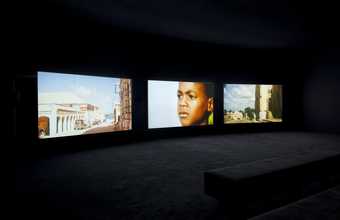
Sir John Akomfrah CBE
The Unfinished Conversation
(2012)
Tate
Our role at Tate is to share art in all its complexity and diversity. In recent years we have made progress in better representing artists of colour in our collection and our programmes, but that work must go much further. We know, too, that not everyone has equal access to art and its benefits. We are committed to changing this through our work, and to challenging ourselves to dismantle the structures within our own organisation which perpetuate that inequality.
The founding of our gallery and the building of its collection are inextricably connected to Britain’s colonial past, and we know there are uncomfortable and inappropriate images, ideas and histories in the past 500 years of art which need to be acknowledged and explored. We also recognise the intersections of race, gender, sexuality and class in the experience of inequality.
These are not new aims for Tate. We have a stated objective to become a more inclusive institution that reflects the world we live in now. But progress has not been fast or significant enough.
This page details Tate’s ongoing commitment to race equality. It will be regularly updated with information about what we are doing to address structural racism, charting our progress towards becoming a more inclusive organisation as part of an open and transparent process. It uses ‘Black, Asian and/or minority ethnic (BAME)’ as a signifier, however we recognise the discomfort that this terminology produces in reducing individuals of diverse heritage to a single category, and we are working to address this.
December 2022
Developments over the last six months include:
- Since its inception in summer 2020, 70% of Tate’s Race Equality Taskforce’s initial recommendations have been actioned, with progress being made across remaining areas. The Taskforce has recently entered into long-term, cross-sector dialogue with peer institutions, in order to learn from varying approaches to race equality, initially meeting with the British Library and the V&A.
- Tate recently announced that celebrated British artist Keith Piper will create a new work to be shown alongside and in dialogue with the Rex Whistler mural at Tate Britain. Piper is renowned for his artistic responses to specific historical relationships and geographical sites, after rising to prominence in the 1980s as a founder member of the BLK Art Group. His unique voice will bring a new perspective to the room, juxtaposing past and present in an ongoing conversation. This approach was developed through a series of discussions which invited perspectives from inside and outside Tate, including artists, art historians, cultural advisors, civic representatives and young creative practitioners.
- Recent acquisitions by Tate reflect an ongoing drive to hold and show work by increasingly diverse artists, across a range of mediums, including photography by Larry Achiampong and Sunil Gupta; paintings by Frank Bowling and Lynette Yiadom-Boakye; sculptures by Donald Locke and Sung Tieu; film and video works by Sonia Boyce and Buhlebezwe Siwani; and installations by Sammy Baloji and Grada Kilomba. Works by Frieze Artist Award 2022 winner Abbas Zahedi, and indigenous Australian bark painter John Mawurndjul, entered the collection for the first time.
- In November, Tate launched the Black Atlantic – a project consisting of a series of short films presented by curator and writer Ekow Eshun, and an online course – which examined how contemporary artists are exploring ideas around the Black Atlantic in their work. The themes covered in the film series were explored in more depth in the course, led by Adjoa Armah alongside a host of academic speakers.
- Following extensive research into Tate’s visitor demographics, key recommendations for attracting a more diverse audience that is representative of the towns and cities we serve have been shared across the organisation. The process involved detailed analysis of attendees to both paid-for and free programming across all galleries, to examine what achieves meaningful change in our audiences.
- Tate has recruited 25 new Guides with lived experience to deliver African Heritage and LGBTQIA+ Tours, to increase the diversity of our programming both in terms of the team who deliver tours, and the content itself. This has enabled us to continue to reach new audiences.
- The proportion of visitors to Tate Modern who identify as Black, Asian or minority ethnic increased to 23% between July and September. The increase coincided with Tate Modern’s summer Uniqlo Tate Play programme, aimed at families and young people from the local area, which is successfully drawing in an increasingly broad range of audiences from different backgrounds.
Further actions and progress can be viewed in the dropdown sections below.
Updated on 20/12/2022
